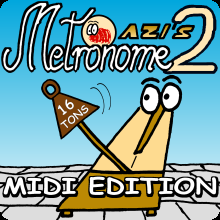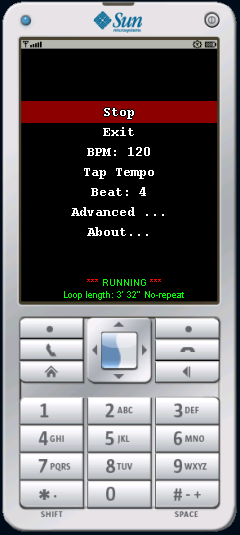|
Azi's Metronome 2 - MIDI Edition |
|
A Free Metronome for your Mobile Phone |
Back to Music Page | Main Software Page |
 Copyright (C) Aziraphal 2011
Copyright (C) Aziraphal 2011Current version: 1.0.00 Stop wasting my time, take me straight to downloads! Don't panic; what's this Do you want do detect buffer now thing?? We now have a Troubleshooting n' FAQ section!
This is a metronome, a wonderful machine that goes CLICK residing in your cellphone, helps you improve your rhythm and is universally hated by all lackluster music pupils. No more, no less. For this very cause the User Interface is just as miserable as the one you see on the screenshot. No bloody revolving 3d raytraced metronomes will ever dance around the screen, I swear it. But hopefully this little gadget will do its job of going CLICK properly, just as good or even better than some of the J2ME metronomes out there that I've tested and they all sucked, which inspired me to start writing my own... and because Azi's Metronome 1 sucked too, the combined suckage inspired me to write a sequel!! Is this any better than version One? Oh yes! This one works by generating and playing a long MIDI click track, rather than triggering individual sounds, which has proven to be the only reliable method of keeping exact tempo in Mobile Java applications. Among all the previous features it also supports composite beats (2+3, 3+4 etc), custom selection of MIDI percussion tones for up/downbeat and much more! The Main Menu
The "Advanced" Menu
"Do you want to detect buffer size now?"
When running for the first time, this dialog is displayed by default; it can also be accessed from the Advanced menu.
Choosing Yes runs a detection process. The gadget will test various buffer lengths and minute durations until the click track can run with no errors. It can take a few minutes so be patient. If it freezes for real (nothing happening for a minute or more) or fails to find a match even after several minutes, shutdown the app (or the phone, whatever it takes) then set the buffer / duration manually using the Advanced menu on restart.
NOTE: The detected buffer size might be very large and able to execute, but the processing time before it's played (when you hit START) might be very long. In that case, go to Advanced -> Buffer and decrease length to e.g. 256k. I'll think about some optimisation of the detection process, when I got time :)
How to calibrate your ticker
As mentioned before, I've not yet discovered a phone that plays MIDI files terribly off-beat, but anything goes in the cruel J2ME world. So if it happens to you: The calibration value means how many seconds of actual time takes a minute of the MIDI player's time.
This is a pretty annoying way to do it but hey, you get what you paid for. So work with me.
- Set tempo to something that amounts to seconds counting (like 60 bpm, beat 1 or, I prefer 120 bpm, beat 2) - Get a hold of a trusty stopwatch - Run the Java metronome - Get ready :) - When you be ready, on a click sound run the stopwatch. Then count 60 clicks under your alcoholic breath, but - starting with 0!! 0,1,2,3,...60! (only us programmers can do that, right? Prove me wrong! :P ). On click number 60 stop your stopwatch. - Read the seconds on it - that's your calibration value!! Troubleshooting n' FAQ Q. The application won't load A. Check your phone's specs, does it support MIDP 2.0 / CLDC 1.1 and Java apps at all? Q. It says "MIDI not supported" on startup A. Tough luck. Try Azi's Metronome 1 or better yet, buy an electronic metronome. Ibanez MU40 rocks. Q. There's no sound, but it says *** RUNNING *** after I hit Start! A. You most probably have sound turned off; you might be using Silent Profile or something like that; it might be just a Java apps-specific setting - see your phone's manual; some models turn Java apps sound off by default (and who can blame them, the music in java games is usually terrible) Q. The ticking takes an eternity (over 1 minute) to start! (Alternatively, Buffer detection took an eternity to finish!) A. (This was first noticed on a Blackberry) On some devices that have enormous RAM it takes a while to generate and play a 4096k-long MIDI file; decrease the buffer (Advanced -> Buffer) to e.g. 256k and try again. (Note: there might be another build soon where you won't get 4096 by default on high-end devices since it's way too much overhead .. Q. The clicking stops after .. minutes! A. Try Advanced -> MIDI Buffer, set it to as high value as possible without causing errors on start, then do the same with Duration. The length is displayed on the bottom of the display after the ticking starts. (see screenshot) Alternative, try setting the Looping option in Advanced Menu to YES. Q. When hitting Start, I get an "Out of memory" error A. Try Advanced -> MIDI Buffer, set it to a lower value and try again Q. When hitting Start, I get an "device error" message A. Try Advanced -> MIDI Buffer, set it to a lower value and try again; alternatively try Advanced -> Duration and set it to 9 (or less) minutes, try again... experiment a bit Q. The timing is off, it's too slow/fast A. Try the calibration trick described here. Q. How can I say how much I appreciate your hard work and superhuman coding skills? A. Listen to my music here and e-mail me how much I rock :) Buy a tune/album here. Or play Azi's Turbo Worm and Azi's Gerbil of Armageddon and let me know the same. RAQ (Rarely Asked Questions) Q. Can we get instrument sounds instead of percussion? A. No. This is a metronome, not a mobile MIDI workstation. Q. Can we get swing rhythms? A. No, beacuse a) I can't be bothered to write it and b) Swing, as any decent jazz musician will tell you, is not pure 2/1 thirds but is a divine fuzzy ratio that the gods see fit to grant you .. or not. Q. How about x+y+z+a+b+c.. beat, ritardandos, aleatoric tempo changes?? A. Shut up. Azi's Metronome 2 is Album-Ware.  You can use it for all eternity free of charge, no nag screens, no time limits, no nothing. HOWEVER! If you find your life significantly enriched by Azi's Metronome 2, consider surfing over to cdbaby.com/cd/Aziraphal and ordering the author's CD. You'll not only own one of the best indie electronic/classical music CD's out there, you'll make the author very happy and eternally grateful.
You can use it for all eternity free of charge, no nag screens, no time limits, no nothing. HOWEVER! If you find your life significantly enriched by Azi's Metronome 2, consider surfing over to cdbaby.com/cd/Aziraphal and ordering the author's CD. You'll not only own one of the best indie electronic/classical music CD's out there, you'll make the author very happy and eternally grateful.
|
|
Minimum Requirements First, let's get this over with. This is a J2ME (Java Micro Edition) application. Even us oldtimers with ancient bricks should be able to use it. It was thoroughly tested on my Nokia 6060, which (by today's standards) is primitive beyond words. But make sure your phaser supports this:
Azi's Metronome 2 (MIDP 2)Surf your gadget over to mobile.aziraphal.com and hit the correct link. See notes above. Current version: 1.0.00 Change history:
|
EULA or something.
|
Back to Music Page | Main Software Page |
|
|
